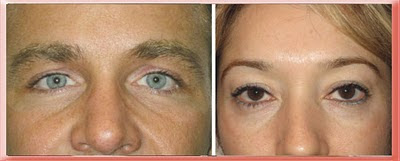Please tweet and retweet
Tweet
Patients with dark circles under their eyes complain that they look tired. The condition is called periorbital hyperpigmentation. Environmental factors that make the condition worse include sunlight exposure, hayfever, lack of sleep, stress, alcohol overuse and smoking.
The condition is classified by appearance as:
- pigmented (brown color)-congenitally darker skin, nevus of Oti or Hori, dermal melanocytosis, side effect of eyedrops, inflammatory induced pigment increase associated with atopic or allergic dermatitis or eyelid rubbing associated with allergies
increased pigmentation from inflammation
- vascular (blue, pink, purple color)-increased blood vessel density
blue color and structural (tear trough) both treated by filler injection
- thin skin making the underlying muscle color visible
thin lower eyelid skin shows muscle under it
- structural (shadows formed by the surface contours such as eyelid bags, eyelid swelling or tear trough visibility associated with aging)
shadows from eyelid bags
- mixture of 2 to 4 of the above classes
structural shadow from malar bags and over pigmented brown lower eyelid skin that is more visible after bags are removed






